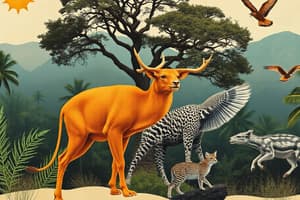Podcast
Questions and Answers
What are the primary causes of decline for the Bengal Tiger and the Asian Elephant?
What are the primary causes of decline for the Bengal Tiger and the Asian Elephant?
Habitat loss & degradation, and exploitation through hunting and fishing
What are some threats to the Indian wildlife biodiversity?
What are some threats to the Indian wildlife biodiversity?
Habitat degradation, over-exploitation, deforestation, reclamation, mining, roads, dams, pollution, and habitat fragmentation
What percentage of plants, mammals, and birds are threatened in India?
What percentage of plants, mammals, and birds are threatened in India?
10% Plants, 20% Mammals, 5% Birds
What is a wildlife corridor?
What is a wildlife corridor?
What are some examples of factors contributing to biodiversity loss?
What are some examples of factors contributing to biodiversity loss?
What are some specific examples of the impact of human activities on wildlife populations?
What are some specific examples of the impact of human activities on wildlife populations?
What is the purpose of the World Heritage Convention 1972?
What is the purpose of the World Heritage Convention 1972?
What is the focus of the Bonn Convention on conservation of Migratory species?
What is the focus of the Bonn Convention on conservation of Migratory species?
What is the main objective of the Indian Forest Act 1927?
What is the main objective of the Indian Forest Act 1927?
What is the significance of the Chipko movement?
What is the significance of the Chipko movement?
Flashcards are hidden until you start studying
Study Notes
Threats to Indian Wildlife Biodiversity
- Habitat loss and fragmentation due to urbanization, agriculture, and infrastructure development are primary causes of decline for the Bengal Tiger and the Asian Elephant
- Human-wildlife conflict, poaching, and climate change are additional threats to Indian wildlife biodiversity
Biodiversity Loss in India
- Over 50% of plants, 30% of mammals, and 20% of birds in India are threatened
- Human activities such as deforestation, mining, and pollution contribute to biodiversity loss
Wildlife Corridors
- Wildlife corridors are designated routes that connect fragmented habitats, allowing species to migrate, disperse, and interact
- Corridors help maintain population viability, genetic diversity, and ecological processes
Factors Contributing to Biodiversity Loss
- Habitat destruction and degradation
- Overexploitation of resources
- Climate change
- Pollution
- Invasive species
Human Impact on Wildlife Populations
- Habitat fragmentation and human settlements lead to human-wildlife conflict
- Overhunting and poaching threaten species survival
- Pollution and climate change disrupt species' habitats and lifestyles
International Conservation Efforts
World Heritage Convention 1972
- The convention aims to preserve cultural and natural heritage sites of outstanding universal value
- It promotes international cooperation to conserve and manage heritage sites
Bonn Convention on Conservation of Migratory Species
- The convention focuses on conservation of migratory species and their habitats
- It promotes international cooperation to conserve and manage shared species
National Conservation Efforts
Indian Forest Act 1927
- The act regulates the management and conservation of Indian forests
- It aims to ensure sustainable forest management and conservation of forest resources
Chipko Movement
- The Chipko movement was a non-violent protest against deforestation in the 1970s
- It highlighted the importance of forest conservation and community involvement in environmental issues
Studying That Suits You
Use AI to generate personalized quizzes and flashcards to suit your learning preferences.




